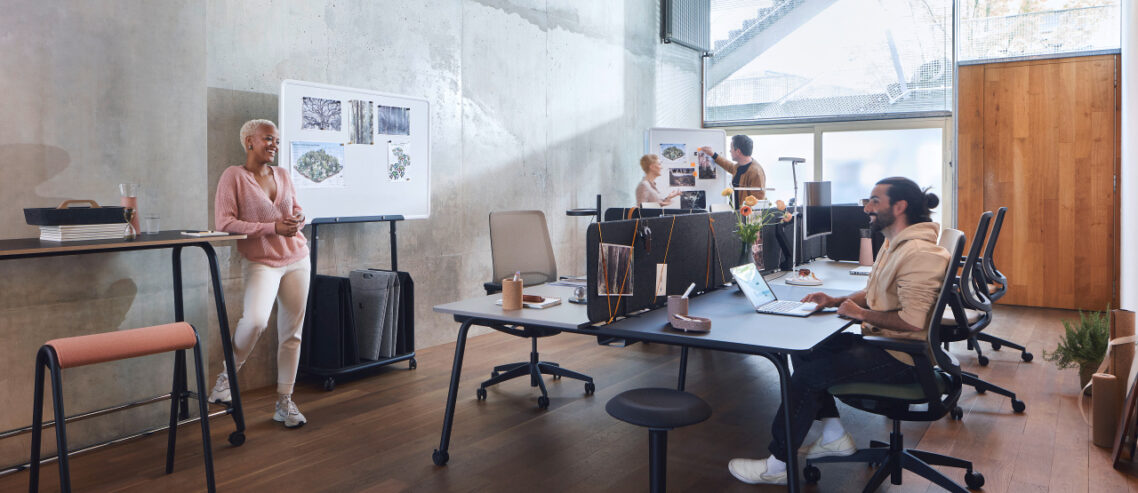How will we work in the future? Together – agile and creative
Developing new approaches and looking at issues from a different perspective can be enormously helpful in finding solutions and breaking new ground. When motivated, individuals become interdisciplinary teams. They work together creatively and combine their ideas in the best possible way. It is then possible to rethink the topics of today and tomorrow in the context of new horizons. And this is where design thinking comes into play – because tomorrow we will work differently.
The Idea of Design Thinking
 If there is a complex problem, the design thinking approach offers the possibility of finding an innovative solution using a systematic approach. It’s about overcoming outdated ways of thinking and working models and focusing on people.
If there is a complex problem, the design thinking approach offers the possibility of finding an innovative solution using a systematic approach. It’s about overcoming outdated ways of thinking and working models and focusing on people.
New ways of agile working are so important because work structures and collaboration in companies are constantly changing. In order to follow progress and to develop the best possible strategies and solutions in the interests of customer proximity, Sedus took part in a workshop at the Hasso Plattner Institute last year to experience the design thinking approach. The experts from Potsdam provided important inputs and insights, and two coaches were trained for Sedus. Ultimately, the basic idea of design thinking served as the basis and was reinterpreted as “Sedus Smart Thinking”. A guidebook was designed for the in-house model and the first workshops were actively implemented.
Cooperation with the HPI academy
 The next step finally followed at the end of 2019 – the inclusion of agile furniture for this type of brainstorming and collaboration. The products from the se: lab workshop program were predestined for this . The prototypes from the furniture program were given to the HPI Academy with the desire to put everything through its paces. In terms of agile work in teams and in the context of various work modes, tables, whiteboards and seating were integrated into everyday work and examined in detail.
The next step finally followed at the end of 2019 – the inclusion of agile furniture for this type of brainstorming and collaboration. The products from the se: lab workshop program were predestined for this . The prototypes from the furniture program were given to the HPI Academy with the desire to put everything through its paces. In terms of agile work in teams and in the context of various work modes, tables, whiteboards and seating were integrated into everyday work and examined in detail.
In the test phase at the HPI Academy, many of the se: lab products proved to be helpful and supportive. The feedback was both extensive and specific and, for example, the mobility of some products could be improved. The development of another product, however, was put on hold again. This process of trying out and evaluating has shown that some things can only be experienced in practice. As a consequence and in the sense of user-oriented design, meaningful and profitable decisions can be made.
We’ll work together tomorrow
Michael Fehsenfeld (Head of Competence Centre Markets at Sedus) sums up the product journey as follows: “A large part of the furniture in the se: lab product development project at the time originated in the context of agile working methods. Since we laid the foundations for ourselves at the HPI Academy, it made sense to have prototypes tested there and obtain feedback. Thanks to the working methods and methods at the HPI Academy, valuable feedback on properties and functions was able to flow directly into product development. Concrete, user-oriented, practical. “
The findings from the various areas have shown that tomorrow’s work will be highly agile and flexible and geared towards comprehensive collaboration. The growing complexity presents the world of work with new challenges, but it also opens up new paths. Furniture that supports these approaches is the furniture of the future.
 The online event NEW HORIZONS on June 23rd is about what the future of work could look like. On the occasion of its 150th birthday, Sedus has set up a comprehensive program. Register now and join us on an exciting journey!
The online event NEW HORIZONS on June 23rd is about what the future of work could look like. On the occasion of its 150th birthday, Sedus has set up a comprehensive program. Register now and join us on an exciting journey!
You might also be interested in:
- Sedus Stoll AG: Annual financial statements 2020
- The new Sedus colour cookbook – Edition # 2
- NEW HORIZONS – Ready for the future
- Home sweet home – home and remote work
